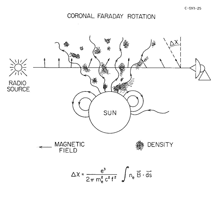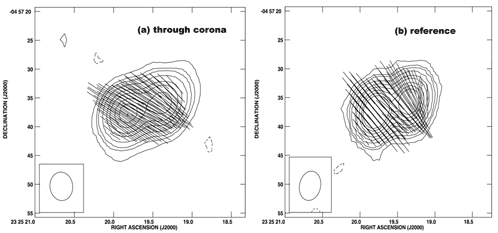
Figure 1: Faraday rotation (Space Science Reviews, 121, 189)
The solar corona is one of the most beautiful objects in astronomy, whether seen by the fortunate few in a total solar eclipse, or on the Internet with current spacecraft pictures. The corona is shaped into loops, streamers, and arcs. A physics student would correctly deduce that this structuring is due to the action of the coronal magnetic field.
The corona is also of major importance in contemporary astrophysics. It forms the base of the solar wind, and processes that occur there are probably repeated on a larger scale in the powerful winds of massive stars. The most intriguing feature of the corona is its high temperature, 1 – 2 million degrees Kelvin, versus 5800 degrees Kelvin for the solar photosphere. Although there have been many proposals for the mechanism or mechanisms responsible for this coronal heating, none of them is universally accepted.
Most theories for coronal heating invoke the coronal magnetic field. Testing these theories requires information on the large-scale field, which determines the overall shape of the corona, as well as on the small scale fluctuations which make up coronal turbulence.
The Very Large Array (VLA) has made a contribution to this effort to probe the nature of the coronal magnetic field. Since 1990, several University of Iowa students have worked with me on observing projects using Faraday rotation to probe the corona. Faraday rotation is a physical process in which the polarization angle of a polarized radio wave rotates as it propagates through an ionized gas (plasma) possessing a magnetic field. The angle of rotation depends on a number of factors, such as the density of the plasma and the strength of the magnetic field along the line-of-sight.
To make things challenging, the actual dependence is on the projection of the magnetic field on our line-of-sight. Thus, a strong magnetic field that is perpendicular to the line of sight has no effect, while a much weaker one parallel to the line of sight can produce a large, observable effect. Because our measurement is proportional to the product of the plasma density and the line of sight component of the magnetic field, we need independent information on the plasma density to obtain a measurement of the coronal magnetic field. Fortunately, the Sun is a well-observed object, and this independent information is available.
A cartoon representation of a coronal Faraday rotation measurement is shown in the figure below.
We choose observing times when a sufficiently bright radio source, usually a radio galaxy, is close to the Sun so its line-of-sight passes through the corona. We then measure its polarization position angle, and when possible, the position angles of several parts of the source.
Coronal observations have an appealing feature relative to similar sorts of observations of radio galaxies and quasars. We can separate the coronal contribution to the polarization position angle from other contributors, such as Faraday rotation in the interstellar medium. We simply observe the source when it is close to the Sun (see Figure 1), and then a few weeks later when the Sun is literally out of the picture. The difference in the polarization position angles is the Faraday rotation due to the plasma in the corona.
An example of a coronal Faraday rotation measurement is in Figure 2, taken from an article by Laura Ingleby and co-workers in the Astrophysical Journal.

Figure 2. A coronal Faraday rotation measurement (Ingleby et al. 2007, Astrophysical Journal 668, 520)
The left illustration shows a polarization image of the source through the corona. The contours are total intensity, and the line segments show the polarization position angles at different points on the source. This image was made at 1465 MHz on March 12, 2005, when the line of sight passed about 2.4 degrees from the Sun’s center. The illustration at right (Figure 2) was made ~ 2 months later, when the effect of the corona was absent. A rotation in the polarization position angles can be seen, corresponding to about 14 degrees. This is a fairly typical amount of Faraday rotation for this distance from the Sun.
Our observing projects have been conducted at 1465 MHz and 1665 MHz with the VLA in the A array or B array. We make the observations when a source is between elongations of about 1.3 and 3.2 degrees from the center of the Sun, or 5 to 12 solar radii. This conveys an idea of how deeply into the corona we can probe.
There are reasons for these limits. If a source is further from the Sun, the plasma density and magnetic field strength in the corona are too low to produce an easily measurable rotation. On the other hand, for lines of sight closer than about 1.3 degrees, the Sun moves into the closer sidelobes of the VLA antennas and the system temperature soars, making the data worthless.
What have we learned from these observations? We find that the polarity of the coronal magnetic field is accurately estimated by the magnetic field in the photosphere. Near times of sunspot minimum, these estimates suggest that about half of the corona has a magnetic field of one polarity, while the other hemisphere has the opposite polarity. Separating these is the coronal neutral line. This model reproduces the sign of our Faraday rotation measurements reasonably well. However, the strength of the coronal field as we measure it is greater than that from a common method of extrapolating the photospheric field, called the “potential field source surface method”. The evidence for this stronger coronal magnetic field comes not only from our VLA observations, but also from Faraday rotation measurements of spacecraft transmitters, made by Michael Bird and colleagues at the University of Bonn (see Bird et al. 1987, Solar Physics 109, 91).
In addition to information on the global coronal magnetic field, we have obtained information on smaller plasma structures in the corona. As we measure the Faraday rotation during an eight or ten hour observing session, we almost always observe variations or fluctuations with time. We believe these are due to the line of sight to the radio source passing through loops and other structures like those seen in eclipse pictures of the corona. Finally, we can measure, or in some cases place limits to, the properties of turbulence in the corona.
Like all types of radioastronomical research, this field will benefit from the availability of the EVLA. The increased sensitivity of the EVLA will permit types of coronal Faraday rotation measurements that are not feasible now. There are two obvious projects to be undertaken in the near future. First, observations should be made at 5 GHz, so we can go closer to the Sun, and therefore probe deeper in the corona. A combination of theoretical and observation arguments indicate that many important thermodynamic processes occur inside the 5 solar radius limit of the 1465 MHz observations. The smaller beam at 5 GHz means the increase in system temperature should occur closer to the Sun, and allow us to make measurements in previously unexplored territory.
Second, it would be interesting to observe radio sources occulted by coronal mass ejections, or CMEs. Coronal mass ejections are big loops of plasma that explosively expand outward from the lower corona. A spacecraft-borne coronagraph picture of a CME is shown in Figure 3. The left-hand frame shows the CME at an earlier stage in its development, as imaged by the C2 coronagraph on the SOHO spacecraft. The right panel shows the same event at a later time, and the image comes from the wider field C3 coronagraph, also on SOHO. A Faraday rotation measurement through such a structure would be fascinating.
The physical processes that lead to CME liftoff are not understood. Measurements of the plasma state in their interiors, such as that provided by Faraday rotation, could help us better understand the basic physics of a CME and the way in which it evolves on its path through interplanetary space.
It is a tribute to the versatility of the VLA that an instrument originally intended for studies of radio galaxies, supernova remnants, etc three decades ago, can also provide interesting and nearly unique information on the corona of our Sun.